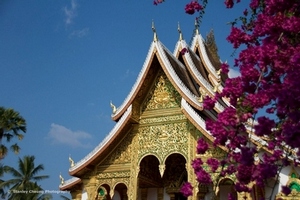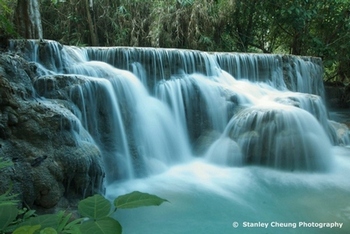Home > Asia > Laos > Attractions



Laos Attractions
Vientiane
The capital of Laos lies on the bank of the Mekong River. The city has kept its timeless charm with tree-lined avenues, brightly painted temples and quaint French architecture. Vientiane's major attractions are the serene Buddhist monasteries that dominate the center of town. Among the most interesting temples, Vat Sisaket, Ho Phra Keo, Vat Ongteu and Vat Simuang should not be missed. Another famous landmark is That Luang Stupa, the symbol of both the Buddhist religion and the Lao overeignty. Vientiane also boosts a lively Morning Market where the best of Lao weaving can be found. Finally the surroundings of Vientiane offer great opportunities for eco-tourism such as boat trips on the Nam Ngeum River and Lake or trekking in the Dane Soung area to discover the unique Mon-Khmer sanctuaries and visit traditional villages.
Khong Island
(815 km from Vientiane)
Located at the southernmost point of Laos, next to the Cambodian border, the Siphandone region (Four Thousand Islands) is blessed by the most scenic section of the Mekong River and some impressive rapids including the magnificent Khone Phapheng Waterfall. Khong Island, with its lovely fishing villages, its serene monasteries and its lush vegetation offers a unique opportunity to experience the peaceful Lao way of life. In the dry season, when the river recedes, the Irrawaddy dolphins, one of the world's largest rarest large mammal species, congregate at the base of the rapids to hunt the fish that survive in the deep pools.
Luang Prabang
(390km from Vientiane)
The former royal city and capital of Lan Xang "The Land of a Million Elephants" lies on the banks of the Mekong River in northern Laos. Famed for its elaborate temples and places UNESCO has declared the entire city a World Heritage Site. Exploring the royal city of Luang Prabang is a simple matter of renting a bicycle or taking to the dusty streets on foot, the town is tiny and can easily be explored in a day or two, though most people choose to stay and absorb the peaceful atmosphere a while longer.
The crown jewel of Laos and former Lanexang, Luang Prabang, at the confluence of the Nam Kham and the Mekong River, is perhaps the best-preserved traditional city in Southeast Asia. Magical and charming, it has maintained its long-standing reputation as a stronghold of Lao culture with its delightful mountain encircled setting, the lovely Royal Palace and more than 30 half-millennium old temples such as Vat Xiengthong, Vat Visoun, Vat May and Vat Sene. Nearby are the sacred Pak Ou Caves housing thousands of statues representating Lord Buddha. In 1995 UNESCO voted Luang Prabang as a World Heritage City.
Northern Mekong
(approximately 450km from Vientiane)
In the Northwestern park of Loas, near the notorious Golden Triangle, Houei Xay is a bustling trading port between Yunnan and Thailand. The region is famous for its precious stones (sapphires and rubies) and gold mining. Various hill-tribes villages can be visited from Houei Xay, including the colorful Lahu, Mien and Lanten. Houei Xay is a major entry point for visitors planning to travel down-river to Luang Prabang. Travellers usually stop overnight at Pak Beng, a rustic town-village that sits on a steep hillside, with spectacular views over the Mekong River. An alternative option is to continue the cruise to the small port of Tha Suang and from there, to travel overland to Hong Sa, where Thai Lu villagers specialize in elephant breeding while women weave some of the most sumptuous Lao textiles. Elephant safaris to beautiful authentic Thai Lu villages and to the pristine White Elephant Forest can be organized.
Van Vieng
(160km from Vientiane)
This small provincial town nestles along a scenic bend of the Nam Song River. The main attraction is the karst topography lining the west bank of the river with sugar loaf hills and dramatic cliffs covered by lush vegetation and peppered by caves and caverns including the famous Tham Xang cave. During the 19th century, Tham Xang cave, with an undergound spring and a stunning view over the valley, was used as a bunker in defense against marauding Yunnanese.
Pakse - Champassak
(approximately 700 km from Vientiane)
Pakse, the capital of the Champassak province, is located at the confluence of the Mekong and Sedone Rivers. It is the perfect gateway to the southern region and to the Boloven Plateau as well as an excellent starting point for excursions to the former royal capital of Champassak, situated 38kms from Pakse along the Mekong River. The pre-Angkorian Vat Phu Temple (6th-13th centuries), near Champassak, was listed as a World Heritage site by UNESCO in 2002 and the Vat Phu Archeological Museum opened doors in 2003 with more than 150 artifacts. Several Khmer sites associated with Vat Phu Temple can be found in the surroundings including Oum Moung Temple (9th century) on the opposite bank of the Mekong River. Nearby is Ban Khiat Ngong village with its enigmatic Phu Asa temple, which lies amidst the dense jungle of Xe Pien NBCA. Elephant riding through the forest to observe the abundant wildlife is a recommended option.
Plains of Jars
(approximately 300 km from Vientiane)
Among the most enigmatic sites in Laos is the Plain of Jars, a large area extending around Phonesavanh city in Xieng Khouang province, where several hundred huge jars of unknown origin are scattered about in over a dozen groupings. The jars, carved from solid stone, vary in shape and in size, the biggest one weighing as much as six tons. The area, which was heavily bombed during the Indochina and Vietnam Wars, is home to a large Hmong community.
All information above are given for reference only. They are subject to change without giving prior notice.
|
|---|
Newsletter Subscription: 訂閱最新旅遊資訊
Site Map · Privacy Policy 私隱政策(只附英文版)
© 2020 Exotic-Holidays.hk · All Rights Reserved.
![]()